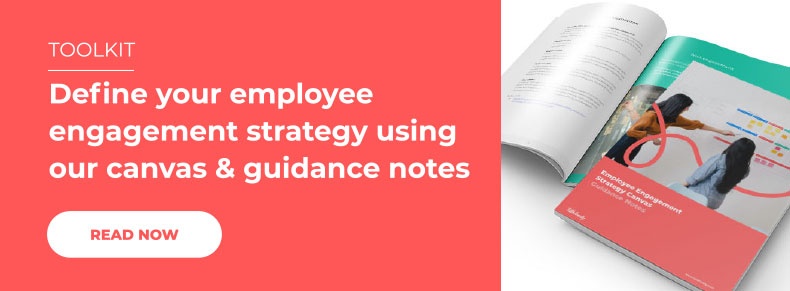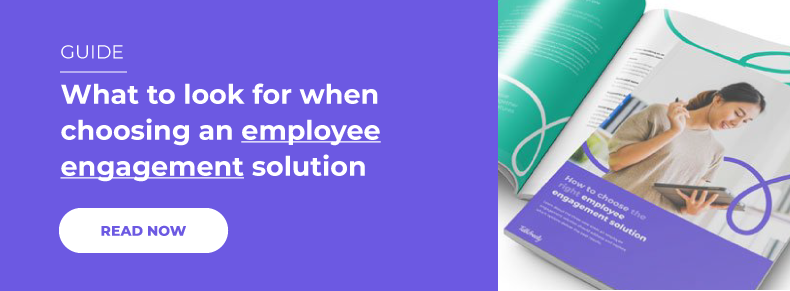The study of employee engagement theory is the bedrock of all engagement strategies. It influences our approach to human resources and internal communications and drives our thinking on how to engage and motivate employees. But the world of business is a very different place in 2021. It is no longer an office-based environment, with easily accessed communication channels and the opportunity for daily interaction with employees. Employee engagement has changed beyond recognition, and our approach to employee engagement theory needs to adapt accordingly.
The latest research from Finder revealed that currently, around 60% of the UK’s population has left the workplace to work from home. In addition, the survey found that 26% of Brits plan to continue working remotely after lockdown finishes. It’s clear we’re going to need to tailor our employee engagement strategy to accommodate this huge new army of remote workers. The best way to address that shift in thinking is to consider how our existing employee engagement theories can be updated.
Back to Basics: Where it all started
The consensus is that the theory of employee engagement began with the work of the psychologist, William Kahn. Kahn is credited with introducing the concept of employee engagement through his three dimensions of employee engagement, which began to answer the question of how to engage employees.
In brief, he identified three dimensions of employee engagement:
1. Physical engagement
The extent to which employees expend their efforts, both physical and mental, as they go about their jobs
2. Cognitive engagement
The understanding of their role and the bigger picture, and the meaning attached to their work
3. Emotional engagement
The level of trust and buy into the overall values and mission of the company
From this starting point, many different models and definitions within the field of employee engagement have evolved. The general theory, however, revolves around the principle that organisational leaders should make efforts to ensure that employees are fully engaged in order to improve performance and productivity. In other words, staff should care as much about their work as they do about other areas of their lives.
Why is employee engagement important? Research confirms the significance of an engaged workforce time after time. It’s closely linked to the quality of management practice. A study by the Office for National Statistics (ONS) found that a 0.1 increase in management quality score was associated with a 9.6% increase in productivity. It also reported that practices such as training, managing underperformance, promotions and performance reviews had a strong correlation with productivity and engagement.
The Development of Engagement Theory
Following Kahn's work, there have been many pieces of academic research undertaken on how to increase employee engagement. Across the last two decades, researchers have produced different definitions of employee engagement to support their findings. Some examples include:
- emotional and intellectual commitment or attachment
- a passion or high level of enthusiasm for the employee's work or job
- the amount of additional effort employees invest in their work
- levels of dedication employees feel towards their work
- positive cognitive, emotional and behavioural states that align with organisational outcomes
While these definitions are different, it's easy to see that they are intertwined and can be linked back to the ONS's findings on the influence of good management practice on employee engagement. In a report by the Institute For Employment Studies, the variety of definitions have been helpfully put into three categories as follows:
1. Company based models
These focus on the alignment of employee commitment, skills and effort ('going the extra mile') with organisational values and objectives
2. Academic models
These focus on the psychology of the mutually beneficial relationship between employer and employee (for example, feeling energised, feelings of dedication and levels of focus)
3. Consultancy based models
These focus on aligning individual and organisational performance and providing a culture where employees feel valued and encouraged
Whichever employee engagement model you choose to follow, it’s clear that management practice has a strong bearing on the levels of employee engagement and motivation.
Taking a personalised approach
The real challenge lies in applying employee engagement theories in organisations where cultures and employment practices are so varied. Worldwide research indicates that employees are more engaged in certain countries, although researchers admit that nations can have different measures, making comparisons more difficult.
This is where engagement research has become more sophisticated. Rather than suggest that studies and research apply across the board, the research is becoming increasingly focused on national and cultural differences. For example, employee engagement statistics suggest that employees in the USA are strongly motivated by understanding and feeling a part of their employers' mission. In contrast, employees in the UK want to work with people who have a shared value base (which possibly also demands good interpersonal working relationships).
The Institute for Employment Studies report takes this theory of employee engagement a step further. It states that research has indicated that employee engagement is influenced by factors such as individual personality, the age profile of a workforce and length of service.
This suggests that general employee engagement theory and practice will only take you so far. You need to obtain good quality information (such as employee engagement survey results) about your employees so that you can pick relevant models that will work for your organisation. For example, does your organisational culture support psychological wellbeing (the consultancy based model)? Or are your employees keen to learn more so that they can make higher-level decisions at work (the company based model)? Employee engagement software can make garnering and collating all of that data easier.
Tailoring the theory for remote workers
We need to take this personalised approach a step further if we are to address the new trend for remote working. Traditional employee engagement theories are based on the assumption that employees are predominantly office-based. Today’s remote workers are facing new challenges not fully considered by the standard engagement theories.
We first need to consider why remote employees might feel less motivated and identify the barriers to employee engagement. There are three key reasons why employees working away from the office may feel less engaged:
1. Absence of management
Management practice has been identified as a key driver in employee engagement theory. Without the physical presence of management figures, the theory needs a new angle.
2. Lack of social connection
Much of the existing employee engagement theory and practice is based on the presumption of social contact. In the absence of real-life contact, an alternative approach is needed.
3. Reduced feedback opportunities
The gathering of quality feedback is at the heart of all engagement theory. Employers need to put new feedback channels in place in order to keep track of this essential information.
When employees are distanced from their managers and peers, they can quickly lose that crucial sense of belonging. What’s needed is a theory of engagement that’s tailored to meet these new demands. It needs to go above and beyond the traditional theory and practices and set about reconnecting employees to the company with strong, targeted employee engagement initiatives.
Improve experience
When your employees are no longer working in the office, you lose control of their working environment. Your aim is to enhance the employee experience wherever they’re based, whether it’s the kitchen table or their spare bedroom.
Try this: Provide an opportunity for conversations by giving workers a social platform where they can chat and share information. An employee app allows you to organise dedicated group conversations as well as private chats, ensuring everyone has a space to connect and bond.
Manage alignment
Alignment is one of the key drivers of employee engagement. If you can keep your employees aligned to your company vision, values and goals and you’ll see an instant improvement in work engagement. Your remote workers are in danger of losing sight of the bigger picture.
Try this: Circulate regular news stories that update your workers about the direction and success of your business. Don’t just deliver facts and figures; explain the thinking behind the strategies. This is a great opportunity to put management figures in the spotlight.
Harness recognition
How to engage employees? Don’t underestimate the power of recognition. Praise is simple to provide in a normal office environment, but harder when everyone is working in isolation. Praise is only truly valuable when it’s made public, so explore new channels for public recognition.
Try this: Employee engagement software will help you forge new channels for recognition. The built-in recognition module will coordinate and plan your recognition strategies, ensuring it’s both formal and public.
Focus on leaders
As the employee engagement theories have proved, management practice is crucial to the success of your strategy. As such, we need our leaders to be more visible than ever. This is particularly relevant for remote workers who feel the absence of their management team.
Try this: Senior leaders need to get actively involved in company discussions by being part of the conversation from the start. Open up two-way channels, allowing employees to not just hear from the boss, but also feedback on their thoughts and opinions.
Engagement theory in practice
Has the research improved employee engagement levels? The jury is out on that one. According to Gallop's Stage of Global Workforce Report, around 85% of employees from across the world do not feel engaged at work. However, the CIPD reported from its Employee Outlook report that UK organisations were succeeding (albeit slowly) in improving employee engagement levels. It stated that net job satisfaction - in addition to other measures such as the use of initiative and degree of influence at work - has increased.
There are indications, then, that an understanding of employee engagement theory and practice can produce results if done properly. The body of research indicates that organisations that adopt what they need for their specific workforces, whether that means improving management styles, analysing levels of decision making or embracing any other practice, will add meaning to the lives of employees and encourage engagement.
Five principles to take away
Despite the varying pieces of research out there, several overarching principles can be gathered from our review as follows:
- The theories have moved from 'one size fits all' approaches to those which take account of national, cultural and individual differences.
- Understanding what is meaningful at work means that organisations must have a better understanding of their employees, which can be achieved through high quality employee-manager relationships and an employee engagement platform
- Working relationships and communications channels are important, especially in terms of listening to each other
- Positive human resources practices that support all of the above are a key foundation
- Employee engagement theory needs to be tailored to fit with the new ways of working, so that remote workers feel the same level of connection and engagement
Topics:
Employee Engagement









.jpg)
.jpg)